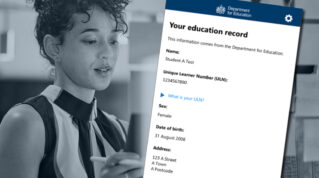The Department for Education has published its provisional key stage 4 school performance data this morning.
It shows stark gaps between disadvantaged pupils and their wealthier peers, with ministers saying the widening “may reflect” the impact of the pandemic.
Sir Peter Lampl, founder of the Sutton Trust, said the government needs to “step up to the challenge immediately”, adding: “There is no time to lose.”
The government urged caution when comparing results over time, because of exams being cancelled in 2020 and 2021 as well as the changes to grade boundaries this year.
Here’s what you need to know …
1. Widest disadvantage gap for a decade
As Schools Week reported this morning, the disadvantage gap among secondary school pupils has widened to its highest level in 10 years.
The gap for pupils achieving grade 5 – deemed by government a strong pass – and above in English and maths has widened from 25.2 percentage points in 2018-19, to 27.3 percentage points in 2021-22.
Government said while grades rose for both sets of pupils, the rise in results for richer students was larger.
Meanwhile, wealthier pupils averaged a progress 8 score of 0.15 compared to -0.55 for disadvantaged pupils – a gap of 0.7.
It means disadvantaged pupils achieved half a grade less than expected by the end of secondary school.
In 2018-19, better-off pupils’ average progress 8 score was 0.13 compared to 0.45 for disadvantaged pupils – a gap of 0.58
The attainment 8 gap has widened from 13.6 points in 2018-19, to 15.1 points in 2021-22.
2. Languages dragging EBacc down (even more)
The percentage of pupils entering the full five EBacc subject groups has remained stable at 38.7 per cent – the same for 2020-21.
Languages is continuing to cause problems. Of those missing just one EBacc component, 87.6 per cent missed languages – compared to 86 per cent in 2018-19.
The percentage of pupils entered for languages this year is 44.8 per cent – the lowest in 10 years. This compares to 94.9 per cent in science and 81.4 per cent in humanities.

The national EBacc average point score has fallen – down from 4.45 in 2020-21, to 4.27 2021-22. But this is up compared to 4.07 in 2018-19.
4. North vs south divide
FFT Datalab said although they feared regional difference has widened, the average progress 8 scores at the regional level have changed “very little” (see table)

Looking at attainment 8, Knowsley has the figure at 36. This is down on the last two years, but up from 33.8 in 2018-19.
Blackpool is second lowest at 37.9 followed by North East Lincolnshire at 41.7.
The top 10 are mainly dominated by London or southern council areas. Sutton tops the table at 60.9 followed by Kingston upon Thames at 60.1.
But Trafford is fourth at 58.
5. Differences in ethnicity…
DfE said the highest average progress 8 score was for Chinese pupils at 0.99, followed by asian and other at 0.54 each.
Black pupils had an average score of 0.18 while pupils from mixed and white pupils are the only ones with negative progress 8 scores – with -0.04 and -0.14 respectively.
Chinese pupils saw the largest decrease of 0.9 percentage points for EBacc entries, despite nationally the rate staying the same between 2020-21 and 2021-22.
But pupils from the Black ethnic backgrounds saw an increase of 1 percentage points compared to 2020-21.
6. … but gender gap narrowing
Girls continue to do better than boys across all the headline attainment measures. But the gap is narrowing.
The gap in grade 5s and above in English and maths has narrowed from 6.6 percentage points in 2018-19 and 7.6 percentage points in 2020-21, to 5.7 percentage points this year.
This gap has also narrowed for the EBacc entry rate, from 11.6 in 2018-19, to 9.9 percentage points in 2021-22.
Girls’ average progress 8 score was 0.15, compared to -0.21 for boys.
7. Strong pass gap widens for SEN
The gap between pupils with special educational needs and others achieving a grade 5 has widened between 2019 and 2021, from 34.4 percentage points to 39.7 percentage points.
Progress 8 scores show that non-SEN pupils averaged 0.10, whereas SEN pupils had an average progress 8 score of -0.69. This means SEN pupils achieved over two-thirds of a grade less than expected.
















Your thoughts